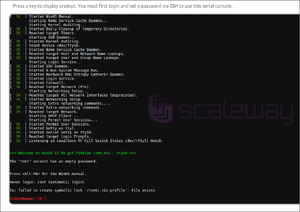Install NixOS on Scaleway X86 Virtual Cloud Server
New method
As of November 2020, it is easy to get a NixOS VM running on Scaleway by using nixos-infect and Scaleway's support for cloud init.
All that is needed is to follow the nixos-infect recipe for Digital Ocean, removing the Digital Ocean-specific stuff.
Pragmatically, start an Ubuntu 20.04 Focal Fossa or Fedora VM and use the following as your cloud-init startup script:
#cloud-config
write_files:
- path: /etc/nixos/host.nix
permissions: '0644'
content: |
{pkgs, ...}:
{
environment.systemPackages = with pkgs; [ neofetch vim ];
}
runcmd:
- curl https://raw.githubusercontent.com/elitak/nixos-infect/master/nixos-infect | NIXOS_IMPORT=./host.nix NIX_CHANNEL=nixos-20.03 bash 2>&1 | tee /tmp/infect.logYou can change the packages you'd like preinstalled by modiffying the list with pkgs.
On login, you will be in NixOS 20.03.
Using the scaleway virtual console
Just add:
boot.initrd.kernelParams = [ "console=ttyS0" ];
to the configuration.nix
Old method
Create Scaleway Instance
If you know the Scaleway API you can do equivalent steps via API instead of using the webinterface.
- Open Scaleway "Create a server" page
- Enter name
- Select region
- Select server type
- This will only work for the V and X types of servers (e.g. VC1M or X64-15GB)
- Select "Debian Stretch" or "Debian Mini Stretch" from the distributions tab
- Create server
- Wait until server has been provisioned and is done booting
- The status of the system can be checked on by looking at the console in the web interface
Build NixOS kexec Tarball
remote build
First you will need to build a NixOS kexec tarball. To do this follow the steps outlined below:
git clone https://github.com/cleverca22/nix-tests.git
cd nix-tests/kexec/
# Edit configuration.nix according to your needs. An example can be found below:
nix-build '<nixpkgs/nixos>' -A config.system.build.kexec_tarball -I nixos-config=./configuration.nix -Q -j 4
copy the NixOS tarball
- Copy the prepared NixOS kexec tarball to the server
scp result/tarball/nixos-system-x86_64-linux.tar.xz root@51.YY.XX.93:
- Use ssh to access the server
- Use the corrensponding SSH key you configured at Scaleway before
- Extract the tarball into /
cd /; tar -xf /root/nixos-system-x86_64-linux.tar.xz
local (Scaleway instance) build
We need to start from 17.09 because that comes with Linux kernel 4.9 which can be Kexec'd into from the Scaleway Debian Stretch. The system to be installed later be any version since it uses the regular boot procedure.
apt-get update
apt-get install -y git
sysctl kernel.unprivileged_userns_clone=1
adduser nix
addgroup sudo nix
su nix # nix installer only runs as non-root
cd
curl https://nixos.org/nix/install | sh
source ~/.nix-profile/etc/profile.d/nix.sh
git clone https://github.com/cleverca22/nix-tests.git
cd nix-tests/kexec/
vim configuration.nix
remove autoreboot.nix, comment out boot.supportedFilesystems = [ "zfs" ]; (as in the sample config below)
NIX_PATH=nixpkgs=https://github.com/NixOS/nixpkgs/archive/release-17.09.tar.gz nix-build '<nixpkgs/nixos>' -A config.system.build.kexec_tarball -I nixos-config=./configuration.nix -Q -j 4
exit # back to root
cp /home/nix/nix-tests/kexec/result/tarball/nixos-system-x86_64-linux.tar.xz /nixos.tar.xz
cd /
tar -xf nixos.tar.xz
Example configuration.nix
(removed autoreboot.nix from imports, added SSH key)
# new cmd: nix-build '<nixpkgs/nixos>' -A config.system.build.kexec_tarball -I nixos-config=./configuration.nix -Q -j 4
{ lib, pkgs, config, ... }:
with lib;
{
imports = [ <nixpkgs/nixos/modules/installer/netboot/netboot-minimal.nix> ./kexec.nix ./justdoit.nix ];
#boot.supportedFilesystems = [ "zfs" ];
boot.loader.grub.enable = false;
boot.kernelParams = [
"console=ttyS0,115200" # allows certain forms of remote access, if the hardware is setup right
"panic=30" "boot.panic_on_fail" # reboot the machine upon fatal boot issues
];
systemd.services.sshd.wantedBy = mkForce [ "multi-user.target" ];
networking.hostName = "kexec";
# example way to embed an ssh pubkey into the tar
users.users.root.openssh.authorizedKeys.keys = [ "ssh-rsa AAAAB3.... Your-SSH-key" ];
}
Start NixOS kexec System
- Execute the kexec_nixos script
./kexec_nixos
- The output should look something like this:
root@scalenix:/# ./kexec_nixos
++ mktemp -d
+ cd /tmp/tmp.iDXuzu8Ec4
+ pwd
/tmp/tmp.iDXuzu8Ec4
+ mkdir initrd
+ pushd initrd
/tmp/tmp.iDXuzu8Ec4/initrd /tmp/tmp.iDXuzu8Ec4
+ cat /ssh_pubkey
cat: /ssh_pubkey: No such file or directory
+ find -type f
+ cpio -o -H newc
+ gzip -9
1 block
+ popd
/tmp/tmp.iDXuzu8Ec4
+ cat /nix/store/2lmw78k2ralvpn6fa270b53nz1xgqk8b-image/initrd extra.gz
+ kexec -l /nix/store/2lmw78k2ralvpn6fa270b53nz1xgqk8b-image/kernel --initrd=final.gz '--append=init=/nix/store/sv9hndbkrdxr1psi2jr82hkm1ba0j8bx-nixos-system-kexec-17.09.git.f3841ab/init loglevel=4 console=ttyS0,115200 panic=30 boot.panic_on_fail'
+ sync
+ echo 'executing kernel, filesystems will be improperly umounted'
executing kernel, filesystems will be improperly umounted
+ kexec -e
packet_write_wait: Connection to 51.XX.XX.93 port 22: Broken pipe
- Once the ssh connection is broken take a look at the servers console in the webinterface. After a while you should see a NixOS root session:
Installing NixOS
Scaleway peculiarities
Scaleway used to start up VMs differently than other providers but new instances are configured for "local boot" which means they can just boot from EFI.
Scaleway Aarch64 peculiarities
If your server is aarch64, there is no working kexec on initrd image provided by Scaleway. So KEXEC_KERNEL tag won't work. This can be worked around by compiling static kexec and copying in to /boot and also by providing fake /sbin/init (a file which Scaleway's initrd launches at the end)
system.build.installBootLoader = pkgs.writeScript "installBootLoader.sh" ''
#!/bin/sh
export TOPLEVEL="$1"
export PATH=${pkgs.coreutils}/bin
cp -f $TOPLEVEL/kernel /boot/kernel
cp -f $TOPLEVEL/initrd /boot/initrd
cp -f ${pkgs.pkgsMusl.kexectools.overrideDerivation(old: {configureFlags = old.configureFlags ++ ["LDFLAGS=-static"]; }) }/bin/kexec /boot/kexec
cp -f ${pkgs.pkgsMusl.busybox.override {enableStatic = true;}}/bin/busybox /boot/sh
mkdir -p /sbin
cat > /sbin/init <<EOF
#!/boot/sh
/boot/kexec -d -l /boot/kernel --initrd=/boot/initrd --append="init=$TOPLEVEL/init systemConfig=$TOPLEVEL $(cat $TOPLEVEL/kernel-params)"
/boot/kexec -d -e
EOF
chmod 0777 /sbin/init
'';
boot.loader.grub.enable = false;
Step by Step Guide
- Mount root volume
mount /dev/vda1 /mnt/
- Delete all existing data from the previous Debian system
rm -rf /mnt/*
- Create mountpoint for /nix on the 2nd volume (I want to use it for the nix store)
mkdir /mnt/nix - Create filesystem on the 2nd volume
mkfs.ext4 /dev/vdb -L nixstore
- Mount 2nd volume
mount /dev/vdb /mnt/nix/
- Create mountpoint for /boot to set up EFI (I want to use it for the nix store)
mkdir /mnt/boot - Mount EFI boot partition
mount /dev/vda15 /mnt/boot
- Generate NixOS config (make sure after mounting /mnt/boot so it recognizes it)
nixos-generate-config --root /mnt
- Edit /mnt/etc/nixos/configuration.nix
- Make sure to add users/keys to access the system later via SSH
- Install NixOS
nixos-install --root /mnt- This might take some time
- Set root password at the end of it
- reboot

